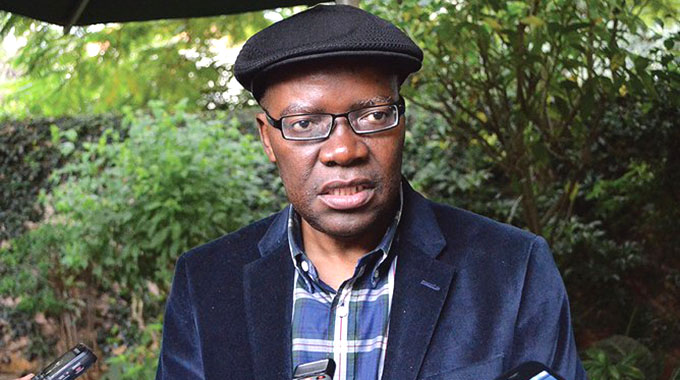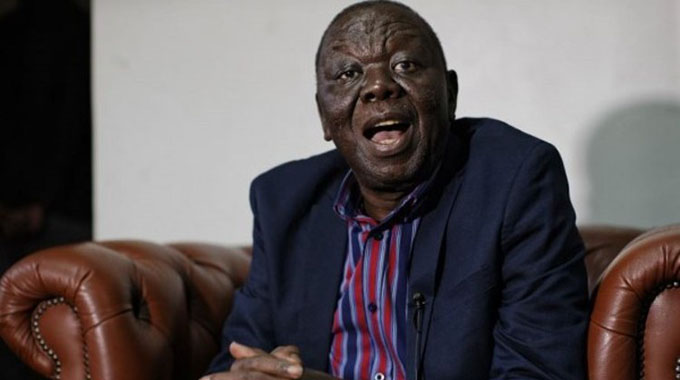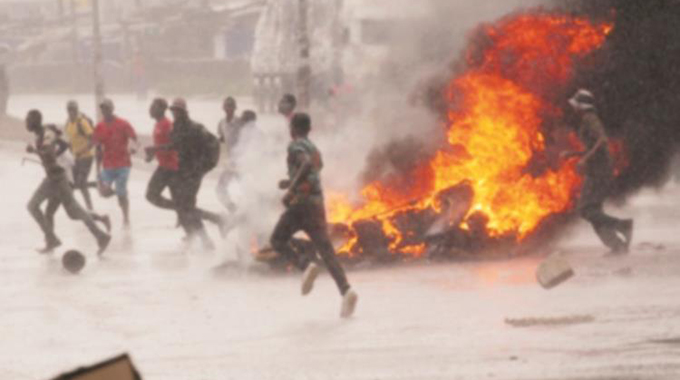Violence: You cannot talk it away

within their countries failing to respond adequately to their political demands and needs. It is this belief that often leads to the unfortunate and rather misguided notion that violence can be justified, that it can be defensible, or can be rationalised. In fact some people become hysterically obsessed with the drive to achieve political objectives that they even argue that violence is not only justified but necessary.
It is this pestiferous culture of enshrining political value in violence that creates governments around the world that sadly believe they need to use violence in order to intimidate their populace into acquiescence – most of the time on pretexts of good intentions like national security or the national interest.
Zimbabwe has had frequent episodes of violent clashes between political opponents from Zanu-PF and the MDC in all its fractious shapes, perhaps highlighted by serious allegations of atrocities raised in the aftermath of the March 29, 2008 harmonised election.
In December 2007 we had over 1 000 people killed in Kenya after a disputed election that was tainted by irregularities like many cases of voter turn outs that were all over 100 percent at constituency levels, a clear sign of ballot stuffing. This year we had deadly violence in the streets of London, resulting in a harsh crackdown on youngsters by the Cameron government, with convictions and sentences for children as young as eleven, with one kid sentenced for “stealing a waste bin.”
The most familiar and most deadly type of political violence is not the counter-bludgeoning between political goons in some backward developing countries as portrayed by most of the media. In fact the deadliest form of political violence in human history is war, itself almost synonymous with imperialist powers, well exemplified by the insanity that brought down Libya from the most prosperous country in Africa down to the most destitute – all in the name of bringing down Gaddafi. As Hilary Clinton aptly put it, the imperialists “came,” “saw” and “he died” – a death that was a laughing matter for the violence inflicting US Secretary of State.
What we have in Zimbabwe is a type of violence that can be classified under forms of violence involving vigilante groups, cult groups, hate groups, terrorists, arguably police brutality, and perhaps the violence of revolutionaries. The activists from both Zanu-PF and the MDC count themselves as revolutionaries, the former regarding themselves as custodians of the liberation legacy and the later bragging about fighting for “a new Zimbabwe,” whatever that means.
In fact political violence is almost always related to the idea of change. The violent acts of political activists are sometimes seen as a mere means to a greater goal – to some desired change. This is why some argue that terrorists have no indicial intent to reek havoc on innocent people. Rather the intention is to create fear leading to a desired change. Peter Sederberg made incisive analysis of political violence and he came up with a number of theses regarding its causes.
He views political violence as a festering wound, which without the aid of antibiotics can have the deadly potential to depress the immune system and eventually to overwhelm the individual, leading to death. One thing noted by Sederberg is that people who engage in political violence cannot answer the simple question of why they engage in acts of violence, often side-stepping the question, and opting to render excuses in the hope that by the logic used in explaining why conflicts must be resolved, this will always justify the means.
So you have Zanu-PF youths believing they are protecting the country from the treacherous acts of their political opponents in the MDC, particularly in the Tsvangirai-led MDC-T. And you have vicious
MDC-T youths believing they are protecting democratic space from the “dictatorial” traits of their political opponents in Zanu-PF.
So the protagonists end up believing that political violence as a means to achieve their political goals is understandable and even acceptable. In many cases the respective parties are complicity in almost every act of violence perpetrated by their members.
States may resort to brute force to make a point. We saw it in Libya when France, the UK and the US teamed up against Col Gaddafi to the point of callously killing him. The point to be made was that when the West says one must go that person must indeed go, and a lot of MDC-T youths have really been energised by the mere imagination that they are “friends” with the mighty Western powers – dreaming daily about Zimbabwe under high-tech NATO fire power, and strangely cherishing with glee the prospect of a Zimbabwe on fire.
Sederberg propounded a number of theses in trying to explain the notion of political violence. He starts off with the “Killer Ape Thesis,” arguing that humans are biologically programmed toward violence, and that because they are programmed this way, one can use this as an explanation for violence.
Discontent is quite silent in the Killer Ape Thesis, that way making the thesis fail to explain the causal factors for an inclination towards violent expression. It is quite hard to believe that biological factors incline people towards violence, but there is no doubt that watching youths attacking each other in Chitungwiza was a sight good enough to conclude that the vicious gangs were indeed “Killer Apes.”
Perhaps Sederberg’s “Cherry Pie Thesis” best explains political violence in Zimbabwe. The argument here is that we are violent because of our culture, because of what we believe, what we have or have not, because of where we are coming from, and of what we aspire to become.
Could it be that our violent youths are not the insane hoodlums they appear to be? The Cherry Pie Thesis will tell us that it is the socio-economic status of these youths that shapes them to an inclination towards violence.
This thesis is premised on the assertion that when people are not happy they will find happiness, one way or the other. We then have MDC-T youths on the one hand saying they are not happy without their preferred politician leading government, and Zanu-PF on the other hand asserting that they can never know happiness if they allow the country to be ruled by proxies of Western imperialists, that way endangering the country’s rich resources. The Cherry Pie Thesis asserts strongly that the proclivity for violence is correlated to social factors, in Zimbabwe’s case to the quest for an escape-route out of the harsh realities of an economy that largely was declining in the last ten years.
Sederberg has a third thesis called the “Insanity Thesis,” itself a presumption that people are violent because they are insane, or because they fail to meet “normal” requirements of functionality. Ideally we should be treating these violent youths the way we deal with every other insane person, confining them to secluded places for rehabilitation, in this case confining them to the jails of the country, if only to make “sane” people go about their normal duties without risking harassment from habitual goons. But our political leaders sometimes find these goons handy, as Welshman will always say about Morgan Tsvangirai and his “Kitchen Cabinet.”
Insanity is essentially the absence of normalcy, and to say we have normalcy within the structures of Zimbabwe’s main political parties is but naive. From the comments in response to newspaper
articles on political violence, it would appear the majority of non-violent Zimbabweans are convinced that perpetrators of violence are smitten with insanity. That feeling is understandable in many ways.
Perhaps it is Sederberg’s “Misery Thesis” that can explain the scourge of violence in Zimbabwe. Is it because we Zimbabweans have had enough misery to warrant a violent revolt that we are seeing all this violence? But what is misery in this case?
Misery is seen by MDC-T supporters as the suffering caused by the excesses of Zanu-PF rule; and for Zanu-PF supporters, misery is the murderous suffering brought about by illegal economic sanctions imposed by Western powers on the country at the behest of the MDC-T in particular.
However, the misery is interpreted, whenever such perceived misery hits rock bottom then one can expect a revolt as an outlet from that misery. It could go either way, or any way. It is the misery thesis that led Morgan Tsvangirai to threaten people with more suffering and hunger until “you remove this regime”. The infamous “Muchashaisisa chaizvo chaizvo” rant that Tsvangirai did at a rally in 2007 was based on the hope that misery would make people revolt against President Mugabe, in the process propping the MDC-T to power.
Finally we may want to look at Sederberg’s final thesis; the “Conspiracy Thesis,” where the argument is that politics are the root cause of political violence. Just like Western powers create a huge
monster out of an imaginary army of what they tell the people are terrorists, politicians will always conspire to taint their political opponents as unlikeable people not deserving of sharing this earth with. This creates intolerance and polarity, themselves chief stimulants for political violence.
Tsvangirai proudly said him and President Mugabe have graduated from being “political enemies” to “political opponents,” urging all of us to emulate this civility. But for as long as Tsvangirai’s politics centres on vilifying Zanu-PF and its leader at rallies the conspiracies that breed hate politics will never go away. Political violence cannot be talked away in a boardroom for as long as our political leaders take rallies as platforms to sow hate and disdain against their political opponents, slandering and defaming them with the ferocity of thunderstorms.
MDC-T rallies are trademarked by the singing of obscenities against the very man Tsvangirai says he is no longer enemy with; they are punctuated with crude ridiculing of Zanu-PF and its leadership, insulting the person of the Zanu-PF leader, deriding anyone associated with Zanu-PF, and name calling the very police force that is meant to maintain peace and order.
It is out of question that one expects to hear policy talk at such a rally as was about to happen at Chibuku Stadium in Chitungiwiza, one addressed by Zimbabwe’s Prime Minister. Although Zanu-PF centres its rally talk on people centred policies like the land reform program and the economic empowerment policy, the party is equally culpable when it comes to conspiring in hate politics against its political opponents. That is how Morgan Tsvangirai’s looks become such an interesting matter in Zanu-PF politics.
For as long as we keep institutionalising a culture of violence the way our political parties are doing it does not matter how many inter-party meetings our politicians may organise, the simple truth is that they will not be able to talk violence away. Lock up the culprits and let this writer keep the keys.
Zimbabwe we are one and together we will overcome. It is homeland or death!
- Reason Wafawarova is a political writer based in Sydney, Australia.








Comments